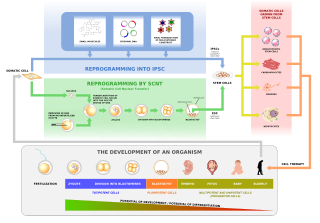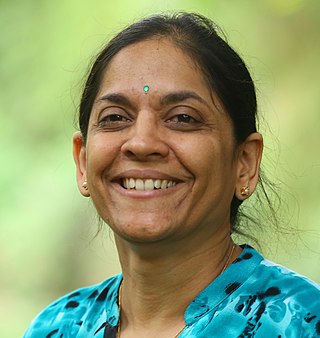
Human cloning is the creation of a genetically identical copy of a human. The term is generally used to refer to artificial human cloning, which is the reproduction of human cells and tissue. It does not refer to the natural conception and delivery of identical twins. The possibilities of human cloning have raised controversies. These ethical concerns have prompted several nations to pass laws regarding human cloning.

Haematopoiesis is the formation of blood cellular components. All cellular blood components are derived from haematopoietic stem cells. In a healthy adult human, roughly ten billion to a hundred billion new blood cells are produced per day, in order to maintain steady state levels in the peripheral circulation.

In genetics and developmental biology, somatic cell nuclear transfer (SCNT) is a laboratory strategy for creating a viable embryo from a body cell and an egg cell. The technique consists of taking an enucleated oocyte and implanting a donor nucleus from a somatic (body) cell. It is used in both therapeutic and reproductive cloning. In 1996, Dolly the sheep became famous for being the first successful case of the reproductive cloning of a mammal. In January 2018, a team of scientists in Shanghai announced the successful cloning of two female crab-eating macaques from foetal nuclei.

CD34 is a transmembrane phosphoglycoprotein protein encoded by the CD34 gene in humans, mice, rats and other species.

Cell is a peer-reviewed scientific journal publishing research papers across a broad range of disciplines within the life sciences. Areas covered include molecular biology, cell biology, systems biology, stem cells, developmental biology, genetics and genomics, proteomics, cancer research, immunology, neuroscience, structural biology, microbiology, virology, physiology, biophysics, and computational biology. The journal was established in 1974 by Benjamin Lewin and is published twice monthly by Cell Press, an imprint of Elsevier.

An organoid is a miniaturized and simplified version of an organ produced in vitro in three dimensions that mimics the key functional, structural and biological complexity of that organ. They are derived from one or a few cells from a tissue, embryonic stem cells or induced pluripotent stem cells, which can self-organize in three-dimensional culture owing to their self-renewal and differentiation capacities. The technique for growing organoids has rapidly improved since the early 2010s, and The Scientist names it as one of the biggest scientific advancements of 2013. Scientists and engineers use organoids to study development and diseases in the laboratory and industry for drug discovery and development, personalized diagnostics and medicine, gene and cell therapies, tissue engineering and regenerative medicine.

Elaine V. Fuchs is an American cell biologist famous for her work on the biology and molecular mechanisms of mammalian skin and skin diseases, who helped lead the modernization of dermatology. Fuchs pioneered reverse genetics approaches, which assess protein function first and then assess its role in development and disease. In particular, Fuchs researches skin stem cells and their production of hair and skin. She is an investigator at the Howard Hughes Medical Institute and the Rebecca C. Lancefield Professor of Mammalian Cell Biology and Development at The Rockefeller University.

City of Hope is a private, non-profit clinical research center, hospital and graduate school located in Duarte, California, United States. The center's main campus resides on 110 acres (45 ha) of land adjacent to the boundaries of Duarte and Irwindale, with a network of clinical practice locations throughout Southern California, satellite offices in Monrovia and Irwindale, and regional fundraising offices throughout the United States.

Shinya Yamanaka is a Japanese stem cell researcher and a Nobel Prize laureate. He is the former director of Center for iPS Cell Research and Application and a professor at the Institute for Frontier Medical Sciences at Kyoto University; as a senior investigator at the UCSF-affiliated Gladstone Institutes in San Francisco, California; and as a professor of anatomy at University of California, San Francisco (UCSF). Yamanaka is also a past president of the International Society for Stem Cell Research (ISSCR).
Cell Press is an all-science publisher of over 50 scientific journals across the life, physical, earth, and health sciences, both independently and in partnership with scientific societies. Many of Cell Press's journals are among the most reputable in their fields. Cell Press was founded and is currently based in Cambridge, MA, and has offices across the United States, Europe, and Asia under its parent company Elsevier.
Stem Cell Reviews and Reports is a medical journal published quarterly by Springer Science+Business Media. It covers contemporary and emerging areas in stem cells, including embryonic and adult stem cells, and related lineage and cloning issues. The journal also publishes reviews covering basic, clinical, biotechnology, regulatory, and ethical aspects of stem cell research and applications. The journal got its current name in 2009 from Stem Cell Reviews. According to Journal Citation Reports, the journal has a 2021 impact factor of 6.692.

Cell potency is a cell's ability to differentiate into other cell types. The more cell types a cell can differentiate into, the greater its potency. Potency is also described as the gene activation potential within a cell, which like a continuum, begins with totipotency to designate a cell with the most differentiation potential, pluripotency, multipotency, oligopotency, and finally unipotency.

Cytotherapy is a peer-reviewed medical journal covering the areas of cell and gene therapy. The journal was established in 1999 and the Senior Editor is Donald G. Phinney. It is published by Elsevier on behalf of the International Society for Cell & Gene Therapy (ISCT).

Cell Stem Cell is a peer-reviewed scientific journal published by Cell Press, an imprint of Elsevier.

Hossein Baharvand is an Iranian stem cell and developmental biologist. He received his B.Sc. in biology from Shiraz University in 1994, and M.Sc. in Developmental Biology from Shahid Beheshti University, Tehran in 1996. He then obtained his Ph.D. in Cell and Developmental Biology from Khwarizmi University in 2004. He first joined the Royan Institute in 1995 in which he founded Royan Institute for Stem Cell Biology and Technology.
Stem Cell Reports is a monthly peer-reviewed open access journal covering research into stem cells. It was established in 2013 and is published exclusively online by Cell Press. It is the official journal of the International Society for Stem Cell Research. The editor-in-chief is Martin Pera. According to the Journal Citation Reports, the journal has a 2020 impact factor of 7.765.

Geeta Kashyap Vemuganti is an Indian ocular pathologist and the head of the department at the Ophthalmic Pathology Service and Stem Cell Laboratory of the L. V. Prasad Eye Institute (LVPEI). She is also a dean and professor at the school of medical sciences of the University of Hyderabad.

Professor Maneesha Inamdar is a stem cell and developmental biologist conducting research at Bangalore, India. She is presently Director of inStem, India’s first stem cell institute. She is on deputation from the Jawaharlal Nehru Centre for Advanced Scientific Research (JNCASR), Bangalore. She is an elected fellow of the Indian Academy of Sciences and the Indian National Science Academy and a J C Bose National Fellow.

Stem Cells is a peer-review scientific journal of cell biology. It was established as The International Journal of Cell Cloning in 1983, acquiring its current title in 1993.

Stem Cell Research is a peer-reviewed open access scientific journals of cell biology. The journal was established in 2007, and is currently published 8 times per year by Elsevier. The current editor-in-chief is Thomas Zwaka.
















